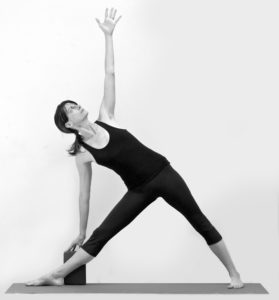
Lateral Standing Pose (Triangle), Modeled by Margi Young
by Leslie Howard
Are you feeling a constant need to go to the bathroom, even though you’ve just been there and don’t really need to go? You may be dealing with an overactive bladder, a form of incontinence that is surprisingly common. This condition, also called urge incontinence, causes an overwhelming need to urinate, but when you get there, you typically do not have a full bladder (which should be about a twenty second flow).
Or, after you cough, to your surprise does your underwear get wet? This is known as stress incontinence, which is typically triggered by impact, such as from coughing, running, or jumping.
Frustratingly, you can sometimes have both these conditions.
Pelvic floor problems such as incontinence affect a surprising number of people, and it’s not just an issue linked to getting older. It can also be triggered by pregnancy and, in men, by prostate problems. About one in four men and women in the US struggle with urinary incontinence. It is not just a medical problem; it can also affect us emotionally and socially, as it often makes us afraid to engage in activities that would make us veer too far away from a bathroom.
Targeted yoga poses and actions in the pose can help significantly. This has now been scientifically proven with a study on yoga for incontinence at the University of California, San Francisco. The lead researcher of the study, Dr. Alison Huang, and her colleagues recruited twenty women from the Bay Area who were 40 years and older and who suffered from urinary incontinence on a daily basis. I designed the yoga protocol that they used to test the effectiveness of yoga for incontinence. The protocol focused on strengthening and balancing pelvic floor muscles, and it included lateral (side-facing) standing poses and hip openers, such as Cobbler’s pose (Baddha Konasana).
Half the study participants were randomly assigned to take part in the six-week yoga therapy program that I designed and the other half, which was the control group, were assigned to take part in a strength training program.
The participants who took part in the yoga program experienced an overall 70% improvement—or reduction—in the frequency of their urine leakage compared to their baselines. The control group—the group that did not start yoga therapy but did strength training only had 13% improvement compared to their baselines.
Isn’t this wonderful news! I’m so pleased to be able to help so many people who are dealing with incontinence, both the group in the UCSF study and the many students I’ve helped over the years in my workshops.
My basic strategy in designing the yoga protocol for this study was the same one that I use when I offer workshops on Pelvic Floor Yoga: offering numerous techniques to find, strengthen, stretch, and balance the pelvic floor.
If you would like to learn more about Pelvic Floor Yoga for incontinence, go to www.lesliehowardyoga.com and sign up for my newsletter to learn about my upcoming workshops on that subject. And if you would like me to teach a workshop on this topic at your yoga studio, contact me at lesliehowardyoga@gmail.com because I would love to spread the word about how helpful yoga can be for people with this condition.

Leslie Howard is an Oakland-based yoga teacher, specializing in all things pelvic as well as other therapeutic applications of yoga . She leads workshops and trainings nationally and has written a book about caring for the female pelvis, Pelvic Liberation. She is a regular presenter for the Yoga Journal conferences and a regular contributor to Yoga Journal magazine. Her own struggles with healing her hips and pelvis led her to intense study of the anatomy, physiology, cultural messaging, history, and energetics of this rich area of the body. Her teaching is informed by over 3500 hours of yoga study with senior Iyengar yoga teachers. She considers Ramanand Patel her most important influence and mentor. She has designed two very successful studies for UCSF on how to use yoga to alleviate incontinence and pelvic pain. Find her at lesliehowardyoga.com.
• Follow Yoga for Healthy Aging on Facebook and follow Nina on Instagram • Order Yoga for Times of Change here and purchase the companion videos here • Order Yoga for Healthy Aging: A Guide to Lifelong Well-Being here.


Leave A Comment